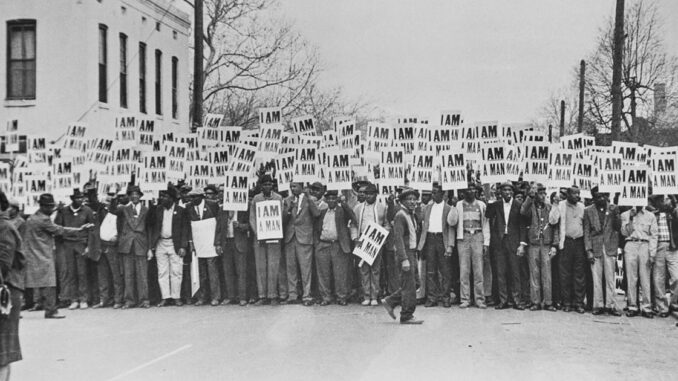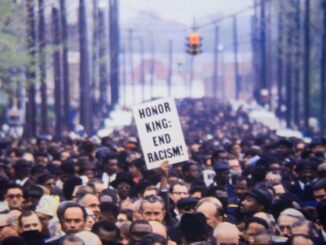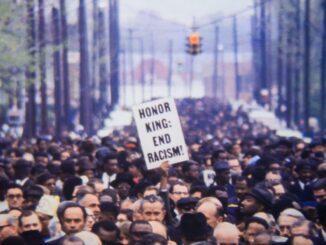
Ernest Withers’ ‘Sanitation workers assemble in front of Clayborn Temple for a solidarity march.’ I Am A Man was the theme for Community On the Move for Equality (C.O.M.E.), 1968.
Let’s take a walk.
It won’t be pleasant, and strife is guaranteed.
Courage was not only necessary but required among the people in the photos in “I AM A MAN: Photographs of the Civil Rights Movement, 1960–1970.”
This traveling show curated by Mid-America-Alliance ExhibitsUSA runs through March 16 at Louisiana’s Old State Capitol, 100 Lafayette St., and features a compelling mix of images taken by amateurs, local photojournalists, and internationally renowned photographers tracing the civil rights movement in the American South.
No flash or glamour will be found here; just the faces of people trying to make things right. And the faces of others who wanted to stop them.

Norman Dean’s ‘National Guard members protecting the bus for the Freedom Riders leaving Montgomery, Alabama, for Jackson, Mississippi,’ taken in Montgomery, Alambma in 1961. The photo was donated to the Alabama Department of Archives and History by the Alabama Media Group/Norman Dean.
So, yes, courage was required for this trek. That’s not saying fear was absent. Yes, all the people in these photos harbored fear, even those who wished to do harm.
Maybe those who hid behind masks were the most afraid — wielding destruction out of fear of the unknown. That’s no excuse for their behavior, it’s simply an amplification of it.
And the photos in the Old Capitol’s upstairs gallery document the good, the bad and the ugly.
Welcome to the 1960s era American South. Some of the places here are agrarian rural, others urban.

Spider Martin’s ‘Rev. Hosea Williams, John Lewis, and others in the March for Voting Rights to Montgomery confronted by Alabama state troopers, Selma, AL, 1965.’
And when you approach the Edumund Pettus Bridge, you realize that some of the places and faces are familiar. But not all.
“The focus is on the 1960s by different photographers, so this show kind of gives you a perspective of this huge timeline of all the things that happened in the ’60s,” said Lauren Davis, the Old Capitol’s museum curator.
She stops in the center of the exhibit, where stands a panel explaining the show’s theme and history. Installed on the back of the panel is a mod 1960s dress, which, Davis has noticed, immediately catches the eye of female visitors
“We borrowed this dress for the show, but women really like it,” Davis said. “But it poses a question about the show. People see it, and they see a representation of this cool, happening girl of the 1960s, who was out partying. But it’s an interesting juxtaposition of what was going, because on the opposite side of the panel, you see this struggle was going on during the decade. There’s just this striking difference.”

A gallery shot in Louisiana’s Old State Capitol of Ernest Wither’s ‘Tent City Family.’ The tent city was created when Black families were evicted from their homes for voting in 1960. This photo was taken in Fayette County, Tennessee.
The walk begins in 1960, when racial segregation was still legal in the United States; progresses to 1961, when Black and White activists staged Freedom Rides by integrating Greyhound buses in the South; to 1964, where the Ku Klux Klan membership grew in record numbers in Salisbury, North Carolina.
The journey continues to 1965, when activists walked 54 miles along U.S. 80, then known as the Jefferson Davis Highway, in the Montgomery Marches.
Two years later, activists A.Z. Young, Gayle Jenkins and Robert Hicks led what was probably the longest civil rights march spanning 105 miles between Bogalusa and Baton Rouge.
Finally, the walk concludes in 1968d with the Memphis Sanitation Strike, when marchers wore placards declaring “I AM A MAN” after the Black workers Echol Cole and Robert Walker were crushed to death in a garbage compactor. That strike also would lead to the assassination to Martin Luther King in the Lorraine Motel in Memphis.

Don Sturkey’s ‘Huge Ku Klux Klan rally in Salisbury, Klan member in robes walks down the street with wife and daughter, Salisbury, NC, 1964.’
The show features photographer Art Shay’s photo of assassin James Earl Ray’s handprint on the wall, where he steadied himself at a boarding house window while taking the shot at King. It’s paired with Ernest Withers’ photo of King’s open briefcase in room 306 of the Lorraine Motel.
But as thought-provoking as these photos are, they represent the headlines at the top of the page while so many others in these galleries never made the newspapers.
There’s the Withers’ photo of the Black family that poses in front of its tent city home after being evicted from its home in Fayette County, Tennessee, for voting in a 1960 election. The man is dressed in work gear, his wife hold an infant. Four younger children stand at their sides.
The husband appears hopeful, but his wife’s expression is panicked. Can anyone blame her?
Juxtapose that photo with Don Sturkey’s of the man dressed in full Ku Klux Klan regalia walking down a Salisbury, North Carolina, street with his wife and daughter.
Each photo depicts ugliness in its own way.

Doris Derby’s ‘Dr. James Anderson, Tufts Delta Health Center physician, examining boy for Head Start Program, the Delta, MS, 1960s.’
Keep walking, and you’ll pass Wilfred Moncrief’s photo of Vernon Dahmer’s aunt, Luranie Heidelberg, looking at the smoking ruins of her nephew’s grocery store in the Kelly Settlement of Hattiesburg, Mississippi.
Dahmer headed the Forrest County Chapter of the National Association for the Advancement of Colored People and was murdered in 1966 by the White Knights of the Ku Klux Klan, which also burned his store.
His aunt’s expression in the photo tells a complete story of the aftermath. It’s not one of anger but one that’s forlorn, asking, “Why?”.
It’s a question you may be asking more than once while passing an unidentified photographer’s image of National Guardsmen standing sentry with their rifles to protect Memphis protesters peacefully marching, again wearing placards reminding observers that “I AM A MAN.” In Norman Dean’s photos, guardsmen also ready their rifles to protect Freedom Riders in Montgomery, Alabama.

An unknown photograher’s ‘U.S. National Guard troops block off Beale Street as Civil Rights marchers wearing placards reading, “I AM A MAN” pass by on March 29, 1968.’
For the protesters, the answer is found in the fundamental rights they were being denied. For those who opposed them, the real question in these photos is “Why cause destruction and pain?”
Some would chalk it up to racism, but the photos depict roles of ignorance and fear playing big parts in this story, as well.
True, it’s a lot to take in, but when look into the eyes of thousands of mourners waiting outside of Atlanta’s Ebenezer Baptist Church during King’s funeral service in Jim Peppler’s photo, you feel a spirit of strength.
The mourners are sad, but they are not beaten.
And it’s with this conclusion that you know your walk with them through this exhibit has strengthened your own spirit.
I AM A MAN: Photographs of the Civil Rights Movement, 1960-1970
WHEN: Through March 16. Hours are 10 a.m.-4 p.m. Tuesday through Friday; 10 a.m.-3 p.m. Saturday.
WHERE: Louisiana’s Old State Capitol, 100 North Blvd.
ADMISSION: Free.
INFORMATION: (225) 342-0500 or visit louisianaoldstatecapitol.org.





Leave a Reply